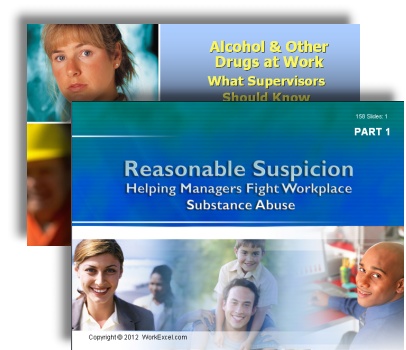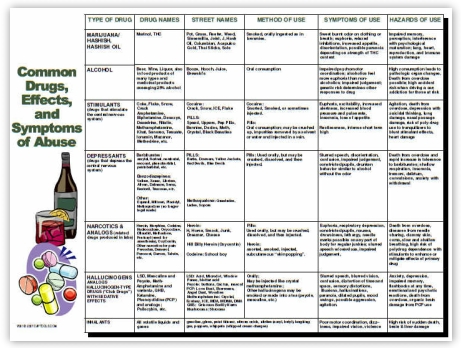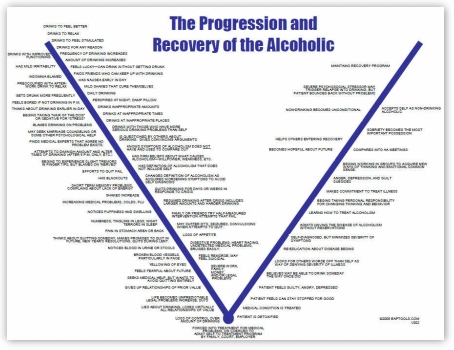- Home
- DOT Supervisor Training for Drug and Alcohol Education for Supervisors Resources, Handouts, and Tip Sheets
DOT Supervisor Training for Drug and Alcohol Education for Supervisors Resources, Handouts, and Tip Sheets
DOT Supervisor Training for Drug and Alcohol Education for Supervisors Resources, Handouts, and Tip Sheets
 Play Program: DOT Reasonable Suspicion Training
Play Program: DOT Reasonable Suspicion Training
DOT Reasonable Suspicion Training (Materials and Handouts) For many employers, DOT reasonable suspicion training for supervisors is a cumbersome task. It may seem like a Herculean feat to ensure the DOT’s 60-minute drug/60-minute alcohol training requirements are met, but it is often retention of the training that proves to be even more problematic.
For many employers, DOT reasonable suspicion training for supervisors is a cumbersome task. It may seem like a Herculean feat to ensure the DOT’s 60-minute drug/60-minute alcohol training requirements are met, but it is often retention of the training that proves to be even more problematic.
It shouldn’t come as a surprise that when training has been completed, the task then turns to keeping supervisors educated. After all, ensuring your supervisors have received the very best training is key to identifying, reducing, and eliminating drug and alcohol incidents in the work place. To keep the information relevant, memorable, and visual, we thought it was important to include tip sheets as part of the DOT reasonable suspicion training package.
Why, you ask? It’s easy for training to go in one ear and out the other. Well written tip sheets help keep important information in hand, keeping supervisors engaged and educated. Each tip sheet has been built, modified, and derived from our work in the trenches with employers just like you.
Continued education starts with gaining an understanding of each of these sheets, what purpose they serve, how they will help educate your supervisors, and the link between education and employee interfacing.
Tip Sheet Title: The Progression and the Recovery of the Alcoholic
What’s it about? This tip sheet uses a progression down and recovery up style structure to walk the reader through the steps, signs, and symptoms of a growing alcoholism problem. This of course is not to teach a supervisor to diagnose. Instead is to educate them in a manner that permits situational awareness, curiosity, ability to spot symptoms quickly for documentation purposes, and better instincts to avoid dismissing what is actually important. At the “point” where the two branches come together, there is a shift to the recovery phase of the process.
How Will This Sheet Help Educate My Supervisors? Knowing the different signs and stages of alcoholism and recovery will help supervisors identify these traits in those they direct and oversee. They can then better make decision on how to address potential concerns or support a recovering alcoholic.
Tip Sheet Title: Common Drugs, Effects, and Symptoms of Abuse
What’s it about? This single-page handout lists types of drugs, names, methods of use, symptoms, and hazards of use. For an individual with limited exposure to drugs or drug usage, this sheet is a very helpful summary.
How Will This Sheet Help Educate My Supervisors? It offers a snapshot of a variety of drugs and their effects. Supervisors will learn what symptoms go with the use of each type of drug. They may also overhear team members using “street names” of drugs, which will tip them off to potential use, ensuring they can address anything concerning. Tip Sheet Title: Understanding Enabling
Tip Sheet Title: Understanding Enabling
What’s it about? Supervisors with DOT responsibilities can't get enough of the education. This is because habits of beliefs die hard. This tip sheet helps employers understand the role they play in enabling the addiction of an employee. The tip sheet defines enabling at work, the impact enabling causes, and the potential losses of such actions.
How Will This Sheet Help Educate My Supervisors? By understanding their role in holding a team member accountable, a supervisor will be better prepared to discontinue the cycle of enabling a team member’s drug or alcohol use. It’s hard to think of drug or alcohol use as being a cause for concern in the workplace, but it should be considered as a potential issue if a team member who has had outstanding performance in the past suddenly becomes a concerning employee.
Tip Sheet Title: How an Employee Using Drugs or Alcohol May Behave
What’s it about? This tip sheet provides a great perspective on how the level of efficiency in the workplace changes as drug or alcohol abuse increases over a period of time. It also includes the behaviors that may be exhibited (i.e. arriving late to work) as this progression takes place.
How Will This Sheet Help Educate My Supervisors? This sheet helps to call out specific behavioral acts that a supervisor should be on the lookout for if they are suspicious of drug or alcohol use. It’s actually surprising to learn what behaviors may be the result of drug or alcohol use, which may otherwise be overlooked (i.e. saying they are being treated unfairly).
Tip Sheet Title: Thinking About Your Drinking
What’s it about? This tip sheet takes a closer look at alcoholism by defining alcoholism and who is susceptible. A self evaluation is  included in the sheet as well as discussion on how to eliminate denial, methods for self-assessment, and suggestions for EAP intervention.
included in the sheet as well as discussion on how to eliminate denial, methods for self-assessment, and suggestions for EAP intervention.
How Will This Sheet Help Educate My Supervisors? Though one might think this specific tip sheet is written for employees to use as a self-assessment, it is a powerful tool for supervisors to offer to team members as well. It is often difficult for a supervisor to broach the subject of addiction with an employee, but this tip sheet helps bridge that gap. It also helps to show how having effective DOT drug and alcohol training for supervisors in place can make a difference in your workplace.
Tip Sheet Title: Checklist for DOT Reasonable Suspicion Training to spot an Employee Under the Influence of Alcohol or Other Drugs
What’s it about? Even the most seasoned of leaders who have undergone extensive DOT drug and alcohol training for supervisors may second guess themselves when it comes to reasonable suspicion. This handout is a great help as it lists specific questions in terms of signs and symptoms to be asked when assessing a team member.
How Will This Sheet Help Educate My Supervisors? By taking the guess work out of a reasonable suspicion assessment, supervisors can feel more confident in their efforts to identify and address potential drug and alcohol related issues in the workplace. This sheet is comprehensive and leaves no stone  untouched. The result of the assessment should leave the supervisor feeling confident in having obtained a true analysis of the situation. Thereby allowing them to take action if needed.
untouched. The result of the assessment should leave the supervisor feeling confident in having obtained a true analysis of the situation. Thereby allowing them to take action if needed.
Tip Sheet Title: Enabling in the Workplace/Functional Alcoholism Isn’t
What’s it about? This tip sheet breaks down enabling in the workplace in to four categories: Supervisor, Coworker, Work/Organization Culture, and High Risk Jobs/Occupations. Each category then lists factors that enable an addict to continue their addiction. For example, a supervisor who may threaten but not follow through on disciplinary action is an enabler. Additionally, the discussion turns to what functional alcoholism isn’t. This means that by saying an individual is a functional alcoholic, you are accepting their alcoholism. The tip sheet asks valuable questions to determine if you are an enabler and shares tips on how to put an end to it.
How Will This Sheet Help Educate My Supervisors? By gaining an understanding of acts of enabling, supervisors can help change enabling behaviors. Much of what causes supervisors, coworkers, or organizations to perpetuate the cycle of enabling is a lack of knowledge of what contributes to it. By gaining a better understanding of how an addict is enabled in the workplace, supervisors can  really make a difference in the support they offer.
really make a difference in the support they offer.
Tip Sheet Title: Reasonable Suspicion Excuses and Missteps: Ten for the Road
What’s it about? Bringing to light some of the most common comments or excuses is the “Ten for the Road” tip sheet. Each comment is followed by the fact that should offset it. This is especially important information for leaders to have when they begin to second guess themselves.
How Will This Sheet Help Educate My Supervisors? It’s a difficult situation for many supervisors to be in when they may have worked side-by-side with a team member who is currently being assessed. This tip sheet helps to ensure that supervisor stays on target. You have to overlook that friendship at times (and the well-practiced excuses of an addict) to make sure you are keeping the company and employees safe, while doing what you can to help the struggling team member get help.
What’s the Link Between Education and Employee Interfacing?
DOT drug and alcohol training for supervisors is critical important. Being well informed, educated, and consistently reminded of the importance of identifying and eliminating workplace drug and alcoholism is the key to a successful training program. Each of the tip  sheets discussed has been written to help remove the guesswork from reasonable suspicion assessment. These tools and resources should help all supervisors to be more confident in their ability to assess, approach, and offer help to a struggling team member. Organizations should thoroughly train their supervisors on the Employee Assistance Program (EAP), its benefits, and how to quickly and easily access it.
sheets discussed has been written to help remove the guesswork from reasonable suspicion assessment. These tools and resources should help all supervisors to be more confident in their ability to assess, approach, and offer help to a struggling team member. Organizations should thoroughly train their supervisors on the Employee Assistance Program (EAP), its benefits, and how to quickly and easily access it.
For more information on comprehensive, insightful, and top of the line DOT drug and alcohol training for supervisors visit WorkExcel.com.
What makes our program unique?
DOT reasonable suspicion training can often be complicated, cumbersome, take hours to complete, all with limited retention. WorkExcel.com has streamlined this process ensuring the DOT’s requirements are met quickly and efficiently. Our program is easily modified to meet your organization’s specific needs, is offered in a variety of formats, allows you to train one or an unlimited number of supervisors, includes test questions and answers loaded with educational content, comes with 8 content-loaded tip sheets, and includes a certificate of completion for all course participants. The program can also be customized to include your organization’s logo, forms, inserts, and handouts. In addition, we offer integration with AICC and SCORM learning management systems.
 Loading... Please wait...
Loading... Please wait...

